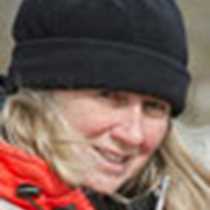Ireland’s Western Coast
The air billowed upwards piling into massive towering thunderheads above the Burren of western Ireland. On the largest of the southern Aran Islands, Inishmore, the electricity seemed to pull our souls spiriting us up a winding rocky trail through ancient fortifications until we could climb no further. Bodies flattened to the smooth limestone floor of Dún Aonghasa to facilitate exploration of the precipitous three hundred foot cliff below. Tiny black eyes peered back up from nests perched precariously on narrow indentations. Effortlessly the fulmar spread its wings barely dropping before being suspended by the wind. The surf crashed like thunder relentlessly eating away at the footings of the precipice.
Shapes and patterns can be found everywhere but nowhere are they more obvious than in the Aran Islands. Ripped by tensional forces and broken by the hand of man, limestone fractures into perfect blocky fragments. Piled one upon the other, these building blocks have been moved by generations with either endless energy or desperate necessity. A semi-circular fort perched on the cliff edge protected by three embracing walls and guarded by strange chevaux de frise. How many men did it take to erect these effective defensive stones? Three thousand miles of rock walls, both perfectly constructed or loose and fragile looking, meandered in random directions enclosing fields both large and small. Within, some vegetables grew in nourishing linear beds, a tribute to ancestral times when peoples living here struggled to create the soil by hauling seaweed and sand far from the shore. The traditional sweaters of the island recreate these shapes and forms.
The sea has a deceptive countenance. Her surface may look smooth and glassy and yet where sea meets shore waves pile in curving lines rushing to the edge and erupting in clouds of spray. Back on the mirror-like surface acids drift in random arrangements. Scattered like stars in the sky, puffins, guillemots and razorbills form into constellations. Like meteors blazing a path, the bird’s pattering takeoff runs smash into the perfection of the sea. Flocks fly by in triangular groupings or follow close behind each other in a perfect line. The Cliffs of Moher are flat topped like those of Dún Aonghasa, but when viewed from below arches and sea stacks project. Generations of birds have decorated the walls with glistening white. They live there still and if one listens closely one can hear the cry of “kittiwake”.
Each pattern, each image is a building block. When woven together a scene is etched upon our memories. Each day, each moment, wherever we are we can enjoy the patterns of nature.
The air billowed upwards piling into massive towering thunderheads above the Burren of western Ireland. On the largest of the southern Aran Islands, Inishmore, the electricity seemed to pull our souls spiriting us up a winding rocky trail through ancient fortifications until we could climb no further. Bodies flattened to the smooth limestone floor of Dún Aonghasa to facilitate exploration of the precipitous three hundred foot cliff below. Tiny black eyes peered back up from nests perched precariously on narrow indentations. Effortlessly the fulmar spread its wings barely dropping before being suspended by the wind. The surf crashed like thunder relentlessly eating away at the footings of the precipice.
Shapes and patterns can be found everywhere but nowhere are they more obvious than in the Aran Islands. Ripped by tensional forces and broken by the hand of man, limestone fractures into perfect blocky fragments. Piled one upon the other, these building blocks have been moved by generations with either endless energy or desperate necessity. A semi-circular fort perched on the cliff edge protected by three embracing walls and guarded by strange chevaux de frise. How many men did it take to erect these effective defensive stones? Three thousand miles of rock walls, both perfectly constructed or loose and fragile looking, meandered in random directions enclosing fields both large and small. Within, some vegetables grew in nourishing linear beds, a tribute to ancestral times when peoples living here struggled to create the soil by hauling seaweed and sand far from the shore. The traditional sweaters of the island recreate these shapes and forms.
The sea has a deceptive countenance. Her surface may look smooth and glassy and yet where sea meets shore waves pile in curving lines rushing to the edge and erupting in clouds of spray. Back on the mirror-like surface acids drift in random arrangements. Scattered like stars in the sky, puffins, guillemots and razorbills form into constellations. Like meteors blazing a path, the bird’s pattering takeoff runs smash into the perfection of the sea. Flocks fly by in triangular groupings or follow close behind each other in a perfect line. The Cliffs of Moher are flat topped like those of Dún Aonghasa, but when viewed from below arches and sea stacks project. Generations of birds have decorated the walls with glistening white. They live there still and if one listens closely one can hear the cry of “kittiwake”.
Each pattern, each image is a building block. When woven together a scene is etched upon our memories. Each day, each moment, wherever we are we can enjoy the patterns of nature.




